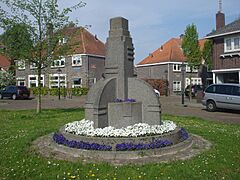Geertruidenberg facts for kids
Quick facts for kids
Geertruidenberg
|
|||
|---|---|---|---|
|
City and Municipality
|
|||

Former city hall on market square
|
|||
|
|||

Location in North Brabant
|
|||
| Country | Netherlands | ||
| Province | North Brabant | ||
| Government | |||
| • Body | Municipal council | ||
| Area | |||
| • Municipality | 29.64 km2 (11.44 sq mi) | ||
| • Land | 26.64 km2 (10.29 sq mi) | ||
| • Water | 3.00 km2 (1.16 sq mi) | ||
| Elevation | 3 m (10 ft) | ||
| Population
(May 2014)
|
|||
| • Municipality | 21,596 | ||
| • Density | 811/km2 (2,100/sq mi) | ||
| Time zone | UTC+1 (CET) | ||
| • Summer (DST) | UTC+2 (CEST) | ||
| Postcode |
4930–4944
|
||
| Area code | 0162 | ||
Geertruidenberg is a city and a local government area (called a municipality) in the North Brabant province of the southern Netherlands. The city is named after Saint Gertrude of Nivelles. It received special "city rights" in 1213 from the count of Holland. This meant it could govern itself more. The city was strong and rich until the 15th century.
Today, the municipality of Geertruidenberg includes the towns of Raamsdonk and Raamsdonksveer. The whole area is about 29.64 km2 (11.44 sq mi). In 2014, about 21,596 people lived here. The local government is led by a mayor and three aldermen.
Contents
History of Geertruidenberg
Geertruidenberg is named after Saint Gertrude of Nivelles. She was a very important person in history.
Early City Life
In 1213, Sint Geertruidenberg, which means "Saint Gertrude's Mountain," got its city rights. These rights were given by Count William I of Holland. This made the city a busy place for trade. Important leaders and nobles often met there to talk and make deals.
Between 1323 and 1325, Geertruidenberg Castle was built very close to the city center. This castle was important for protecting the city.
Wars and Disasters
During the Hook and Cod wars, which were fights between different groups, the city supported the "Cod" side in 1351. However, the castle stayed with the "Hook" side. This led to a long fight called the Siege of Geertruidenberg in 1350–1351. Another similar siege in 1420 caused a lot of damage to the city.
Then, in 1421, a huge flood called the Saint Elizabeth's flood happened. This natural disaster greatly harmed the city. It ended Geertruidenberg's time of great wealth and success.
Later Conflicts
In 1573, during the Eighty Years War, the city was taken over by surprise. English, French, and Flemish soldiers captured it. But in 1589, the city was given away to Parma by its English soldiers.
It was taken back by an army of English and Dutch soldiers in 1593. This army was led by Maurice of Nassau.
Oldest City Fact
Today, Geertruidenberg is part of the North Brabant province. But it used to be part of the county of Holland. Geertruidenberg is actually the second oldest city in Holland. It was the first city to get city rights in that region. Some people mistakenly think it's the oldest city in the whole Netherlands. This is because the names Holland and the Netherlands are sometimes used to mean the same thing.
Geography of Geertruidenberg
The total area of the municipality is about 29.64 km2 (11.44 sq mi). Of this, 26.64 km2 (10.29 sq mi) is land, and 3.00 km2 (1.16 sq mi) is water.
Population Centers
The municipality of Geertruidenberg has three main towns:
- Geertruidenberg
- Raamsdonk
- Raamsdonksveer
Geertruidenberg is located on the bank of the Donge River. This river flows into the Amer River nearby.
Population Information
As of 2014, the total population of Geertruidenberg was about 21,596. The population density was about 811/km2 (2,100/sq mi). This means how many people live in each square kilometer.
Notable People from Geertruidenberg
Many interesting people have come from Geertruidenberg or lived there:
- Johannes Vollevens (1649–1728) was a famous Dutch Golden Age painter.
- Juliana de Lannoy (1738–1782) was an artist and poet. She lived in St. Geertruidenberg from 1758.
- Willem Sassen (1918–2002) was a journalist.
- Jan Derksen (1919–2011) was a professional cyclist. He won world championships in track sprint in 1946 and 1957.
- Matthijs Brouwer (born 1980) is a field hockey player. He won a silver medal at the 2004 Summer Olympics.
Gallery
See also
 In Spanish: Geertruidenberg para niños
In Spanish: Geertruidenberg para niños










